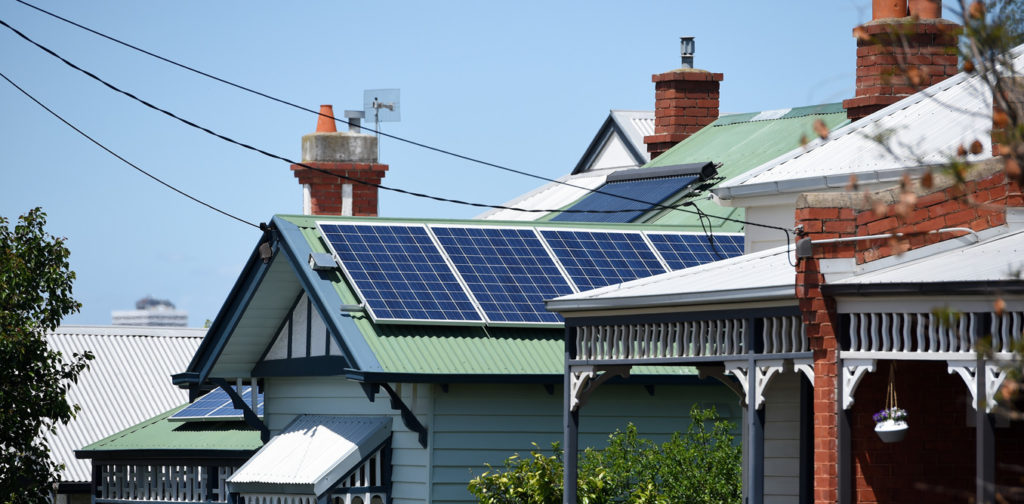
Some states are poised for a 500% growth in rooftop solar panels by 2030. AAP Image/Tracy Nearmy
Solar panels on houses in Melbourne. (AAP Image/Tracey Nearmy)
Home, sweet, eco-friendly home.
The residential sector significantly contributes to Australia’s greenhouse gas emissions, and electricity bills remain high. But Australians are only slowly embracing sustainable and energy efficient housing.
We’ve been working with the team at Renovate or Rebuild to help Australian homeowners choose between rebuilding or renovating while on their quest for healthier, comfier and energy efficient living spaces.
Build me up (Buttercup)
Knocking down an older property and rebuilding a new one may deliver time, cost and design benefits. But what impact does it have on the environment?
When it comes down to what’s greener, renovating often beats rebuilding. However, exactly what’s done with the remodelled or rebuilt house makes an enormous difference.
We track the energy efficiency of new homes through the Australian Housing Data Portal. The good news? Homes are becoming more energy efficient across the country.

Renovate or Rebuild is created around the idea of a Positive Energy Home – a home that is healthy, efficient, comfortable, and that creates more energy than it consumes.
Make it fashion… but functional
According to the Department of the Environment and Energy, Australian households are directly responsible for almost 20% of Australia’s greenhouse gas emissions.
The first step in creating a healthy, efficient, and comfortable home is all about low-tech solutions – orientation, insulation, use of materials, shading, and where you place your windows.
Heating and cooling accounts for 40% of household energy use, making it the largest energy user in the average Australian home. However, very little energy is required to make a well-designed house comfortable, and mechanical heating and cooling shouldn’t used as a substitute for intentional design.
Efficient and well-designed lighting can make for significant energy savings. The first step is to design your home to maximise the use of daylight so that electric lighting is not required during daylight hours. Then, create a lighting strategy that meets your needs in the most efficient way.
Take a load off
Building a positive energy home is all about selecting the right energy efficient appliances, from your hot water system to fridges, freezers, dishwashers, and televisions.
Dispatchable energy generation and storage (like household solar with a battery) is becoming increasingly accessible to the average homeowner. By harnessing solar energy during the day and storing it, you can use your energy on your schedule and even export back to the grid.
While these systems can be expensive to install, rebates and other financial incentives may be available to offset the initial cost.
To get the most out of your renewable energy system, minimising energy demand in the home first is crucial. We’ve compiled a few tips for Summer and Winter, but here’s a reminder:
- Turn off and unplug appliances at the wall when you’re not using them.
- Dress for the temperature by putting on a jumper and warm socks instead of turning on the heater.
- Only use the washing machine and the dishwasher when they are full. Otherwise, adjust the water level to match a partial load.
Watch real Aussies tackle the question of whether to Renovate or Rebuild.


30th April 2020 at 10:07 am
Why is there no energy consideration by planners, architects and/or builders for the orientation of houses and especially roofs? And whatever happened to “sunlight rights”? One recurring problem in the suburbs is the positioning of adjacent buildings and trees that grow over time to cripple the performance of solar hot water and PV installations. My own NW located swamp mahogany tree that we planted 45 years ago is a case in point, in this case an own-goal though redeemed to some extent by its shade in summer. Nevertheless, with thorough insulation during a renovation 17 years ago, a nominally 4kW PV array (generating at best 3.8kW) tilted to face North, hot water panel and occasional use of a slowcom wood heater fed by trees in our back yard, as a two-person household we get by with ~$25/ quarter for electricity.
Growing up on a farm, the big old house was poorly insulated but there were always dropped branches to collect for firewood so the open fireplace and slowcom stove burned most of the winter. Now I live on the city fringe I know there is a smoke-pollution downside to the wood heater so we minimise its use. But a few blocks away in the National Park, the bush is burned every decade or so for bushfire protection (with much smoke at our place) so we justify harvesting dead wood in our backyard patch, weeded and planted with natives, as simply a small extension of the nearby Park that we treasure.